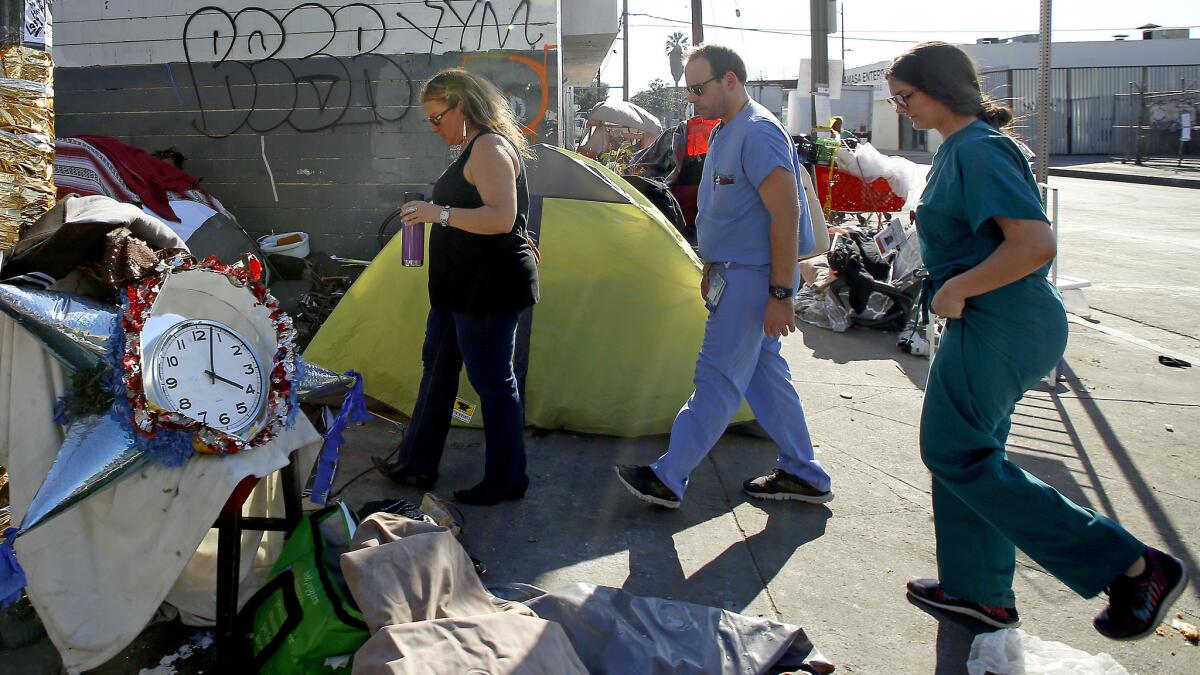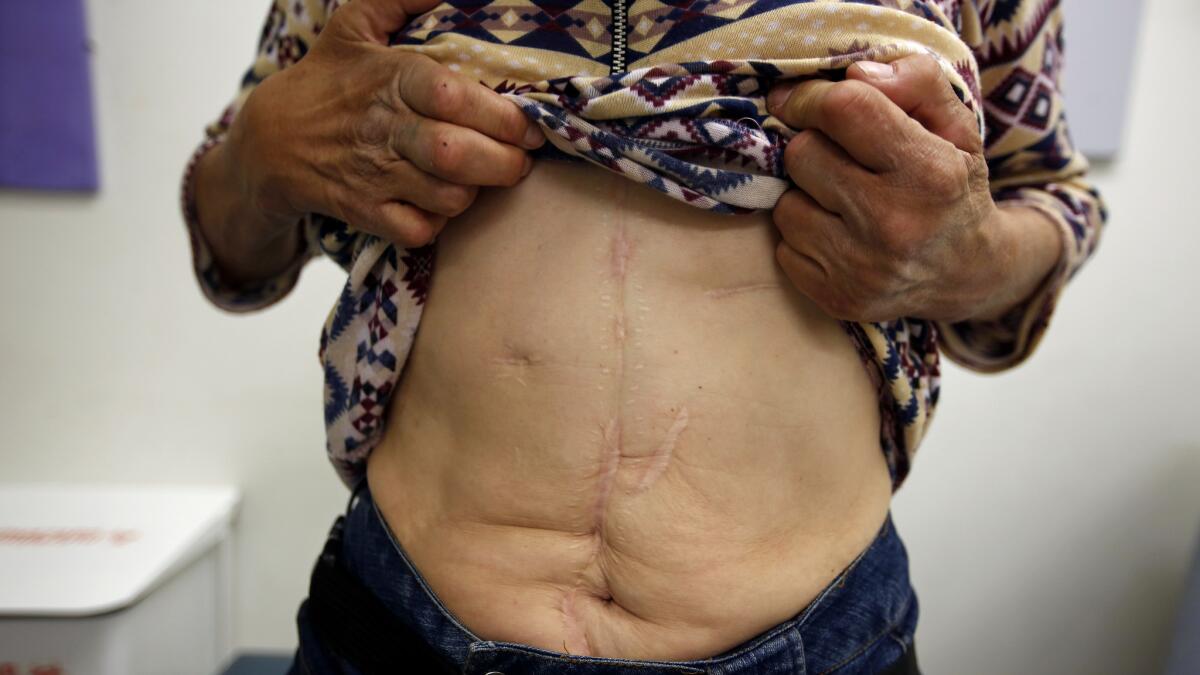Column: L.A.’s chronic challenge: What to do with the mentally ill homeless who refuse help?

- Share via
Down on skid row, the doctor was talking to the social worker about the people they’ve lost, and about who was next in line for a free ride to the graveyard.
“It’s heartbreaking,” said the doctor, who has spent years bringing street medicine to Santa Monica, Hollywood and skid row. “When Barbara died, I said, ‘Julianne’s going to be next.’”
The doctor was right about that.
“Your girl Gloria’s going to be next,” said the social worker.
“You kind of know,” said the doctor.
These are the kinds of conversations Dr. Susan Partovi and Anthony Ruffin, an outreach specialist for Housing Works, have been having for way too long. Despite their best efforts, they’re often unable to convince some of their most mentally ill clients that they need help, or unable to convince authorities that such clients meet the legal standard for involuntary psychiatric treatment.
So Partovi and Ruffin have been talking with like-minded advocates in anticipation of a meeting, scheduled for early next month, at which they’ll try to convince authorities that more aggressive, humane intervention is possible under existing law.
Last week, at a strategy session in the offices of Homeless Health Care Los Angeles, the advocates passed around an outline calling for those who “refuse to accept the status quo” to stipulate, among other things, that “treatment is a right,” and that “to withhold treatment is cruel.”
Nobody this severely ill gets cured during a 72-hour hold, or a 14-day hold or longer.
They’re aware, though, that they need to tread carefully. Celina Alvarez, executive director of the nonprofit Housing Works, said the group needs to make clear that it has no intention of abusing the rights of those with a mental illness or rewriting the law governing involuntary treatment. Instead, they’re interested in a more humane interpretation of existing law, so help is provided to those who desperately need it.
Under California’s Lanterman-Petris-Short Act, police can take a person into custody for psychiatric treatment if it’s believed that due to a mental disorder, that person is a danger to himself or others, or is determined to be gravely disabled.
It’s that last part that offers a little wiggle room, in the minds of the advocates. Grave disability is defined as “a condition in which a person, as a result of a mental disorder, is unable to provide for his or her basic personal needs for food, clothing or shelter.”
As straightforward as that seems, it can get tricky out there, especially when you’re dealing with people who can be delusional. Partovi has had patients tell her they’ve got a place to stay, but Jesus wants them to stay on the street.
“That is not all right,” she said, especially when such patients are so clearly physically ill.
“If you have someone chronically disabled on the sidewalk for 15 years, staining it with their own feces and urine, that’s someone who needs aggressive treatment in my opinion,” said Partovi.
But Ruffin has had clients that sick, and sicker, who don’t get taken in for treatment because they claim they own a house, or that a relative will show up any day now to take them home.
I’m no lawyer, but when that goes on for months and years, it doesn’t seem like you have to stretch the law to determine that the person can’t provide for his or her own shelter.
There ought to be a new standard of care, said Ruffin, and it should include not just temporary involuntary psychiatric and physical treatment, but long-term case management. Nobody this severely ill gets cured during a 72-hour hold, or a 14-day hold or longer. So the idea is to replicate what Ruffin and Kerry Morrison of Hollywood 4WRD have done in that community, where Ruffin tracks clients from streets to hospitals to jails to supportive housing programs and board and care facilities.

Dr. Jonathan Sherin, L.A. County’s new mental health director, said he’s open to reviewing the recommendations of the advocates. He told me he’ll make it “a departmental priority” to work with other agencies and offer more help to those “suffering on the streets” as part of “our overall effort and duty as a society.”
Dan Brzovic, who recently retired from Disability Rights California, said he’s “very concerned about giving people treatment against their will,” but very much in favor of doing more to help people who really need it.
He said you can’t commit someone using the “grave disability” standard if there aren’t adequate resources to treat such people. Historically, he said, there have been stricter interpretations of commitment law when resources were in short supply and looser interpretations when services were more plentiful.
That tells you Partovi and colleagues are onto something in arguing that “grave disability” can be more broadly judged in the interest of helping more people.
L.A. County voters just approved a massive infusion of spending on solutions to homelessness, so in the near future, there should be no excuses for lack of treatment and psychiatric beds and services, both short-term and long-term. Not just for the severely disabled, but for the bulk of the estimated 47,000 homeless people in greater L.A.
You don’t have to go to skid row or Hollywood for a look at the chronically ill people Partovi and Ruffin are talking about. You see them in Santa Monica, the Valley, Long Beach and elsewhere.
I’m talking about the wounded, the hollow-eyed, the weather-beaten souls who curl up in storefronts with their faces covered in dirt and hobble across busy streets on wounded limbs, mortal possessions in tow. Some sink into addiction, chasing relief that never shows itself, and retreat further into madness.
Dr. Partovi calls them the untouchables, for how hands-off we’ve been.
“They’re vulnerable to violence, to weather, to illness,” she said, recalling one in particular who died last year. “She wouldn’t get out of the rain, and she died of exposure.”
Get more of Steve Lopez’s work and follow him on Twitter @LATstevelopez
ALSO
Five ways to end homelessness in L.A.
For people dying on L.A. streets, he offers help
This 94-year-old, shaken after 3 burglaries in 1 week, is not giving in
More to Read
Sign up for Essential California
The most important California stories and recommendations in your inbox every morning.
You may occasionally receive promotional content from the Los Angeles Times.











